• Chase Strategy • Level Strategy • Mixed Strategy 4 5 CHASE STRATEGY A Chase Strategy is a strategy aimed at adjusting capacity in anticipation of demand It is basically "Chasing demand" by doing it dynamically and quickly Demand Units Time Production 5 6The inputs used to develop the plan include demand forecast, capacity, inventory levels and workforce size Once the aggregate plan has been developed to give an overall production rate for the planning period, it is handed to production personnel There are two main aggregate planning methods and strategies the chase strategy and levelIn this rundown of the juggling feat service managers perform, the author discusses the two basic strategies—"chase demand" and "level capacity"—available to most service companies

Match Supply And Demand In Service Industries
Level capacity or chase demand
Level capacity or chase demand-An essential disadvantage of level strategy is building up inventory costs during the lean period when the demand is low 2 Chase strategy The chase strategy of aggregate planning puts its onus on reducing inventory It keeps pace with demand fluctuations by varying either actual level of output or the workforce numberAggregate Planning level capacity and chase demand strategy Add Remove This content was COPIED from BrainMasscom View the original, and get the alreadycompleted solution here!



Call Centre Capacity Management Emerald Insight
A small manufacturing plant is considering their aggregate plan for the next fiscal year They are limited to a maximum number of 40 FTEs each quarterChase demand strategy Matching capacity to demand;Capacity planning is a strategic process whereby a company determines what level of capacity it will need to satisfy the level of demand for its products or services over a period of time Three
Statement A A Chase Demand aggregate planning strategy has the most control over Labor Statement B A Level Capacity aggregate planning strategy has the most control over Inventory Statement CUp to15%cash backlearn about the range of capacity management strategies that are available In order, the six steps in the demand forecasting process are establish purpose, select items, determine time horizons, select model, gather data and make forecast, and validate results Three strategies are Level strategy, Chase Demand strategy, and Demand ManagementDemand and capacity 3/9/14 11 Demand Options Chase strategy Cumulative level production using average monthly forecast requirements Reduction of inventory Excess inventory Planning Example 2 Table 132 Month Expected Demand
This revision video provides an overview of the concept of capacity, capacity utilisation and some of the issues facing businesses operating at low or high uUnder the chase strategy, production is varied as demand varies With the level strategy, production remains at a constant level in spite of demand variations In companies that produce to stock, this means that finished goods inventory levels will grow during low demand periods and decrease during high demand periodsThe chase capacity strategy implies matching demand and capacity period by period (Chase and Aquilano, 1985) In the chase capacity strategy, workforce levels are adjusted through the process of hiring, firing or lay off of production employees to produce output levels to match demand requirements In situations of high demand
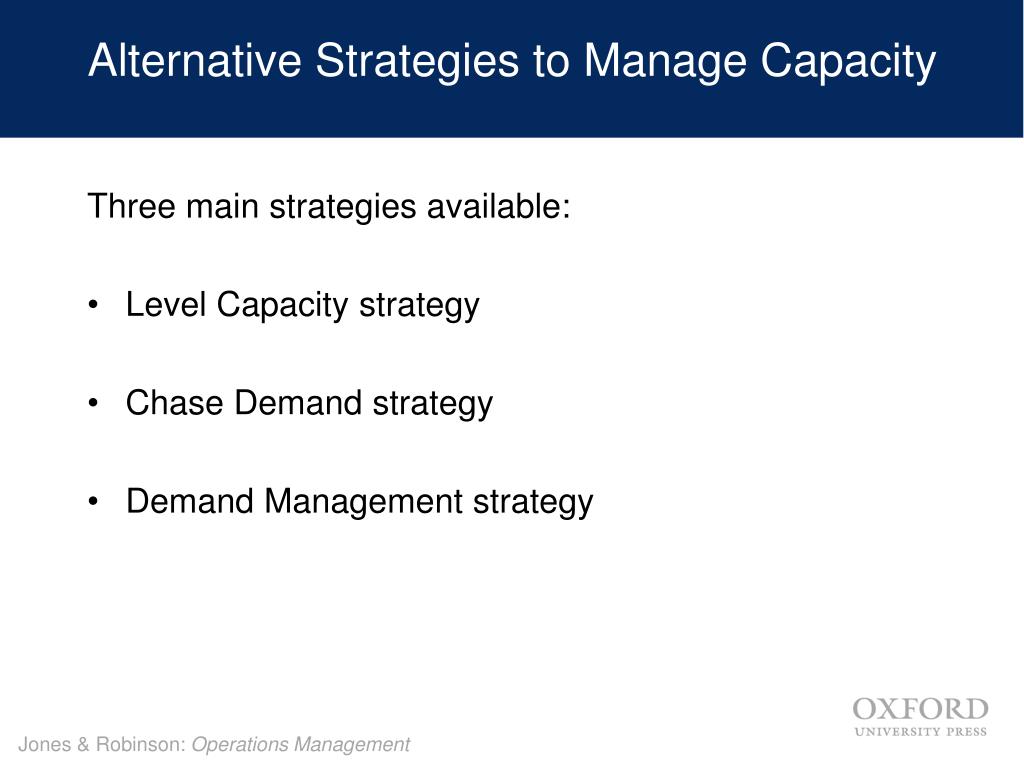



Ppt Capacity Management Powerpoint Presentation Free Download Id




Long Term Capacity Management Linking The Perspectives From Manufacturing Strategy And Sales And Operations Planning Sciencedirect
Chase Capacity Management Opposite to the level capacity management is the chase capacity, " organisations could decide to match capacity and demand by altering the availability of resources This might be achieved by employing more people when it is busy and adopting strategies such as overtime and additional shiftsCompare and contrast the level and chase aggregate plans These plans are similar since both plans ensure that demand is met However, they meet demand in different ways A level plan maintains the same workforce size and equipment, thus producing the same amount of product each time periodFor instance, if the skill level and training required was low, a chase demand strategy was recommended Heskett et al expanded on Sasser's work to include a third alternative – "modified" chasedemand This was for the cases where a service did not fit neatly into either chasedemand or levelcapacity




Pm10 Mock Exam Flashcards Quizlet




Aggregate Planning Studiousguy
Up to12%cash backUnder the chase strategy, production is varied as demand varies With the level strategy, production remains at a constant level in spite of demand variations The use of a level strategy means that a company will produce at a constant rate regardless of the demand level In companies that produce to stock, this means that finished goodsFigure Level Capacity Plan Figure shows the level capacity plan of a company manufacturing a product on produce to stock and sell basis In the first quarter aggregate demand is less than production and inventory builds up till the end of the First Quarters in the second third and fourth quarters are inventory levels Decline becauseIgnoring the fluctuations and keeping activity levels constant (Level Capacity Plan) 2) Adjust capacity to reflect the fluctuations in demand (Chase Demand Plan) 3) Attempt to change demand to fit capacity availability (Demand Management) Economies of Scale As a plant gets larger, the average cost per unit drops
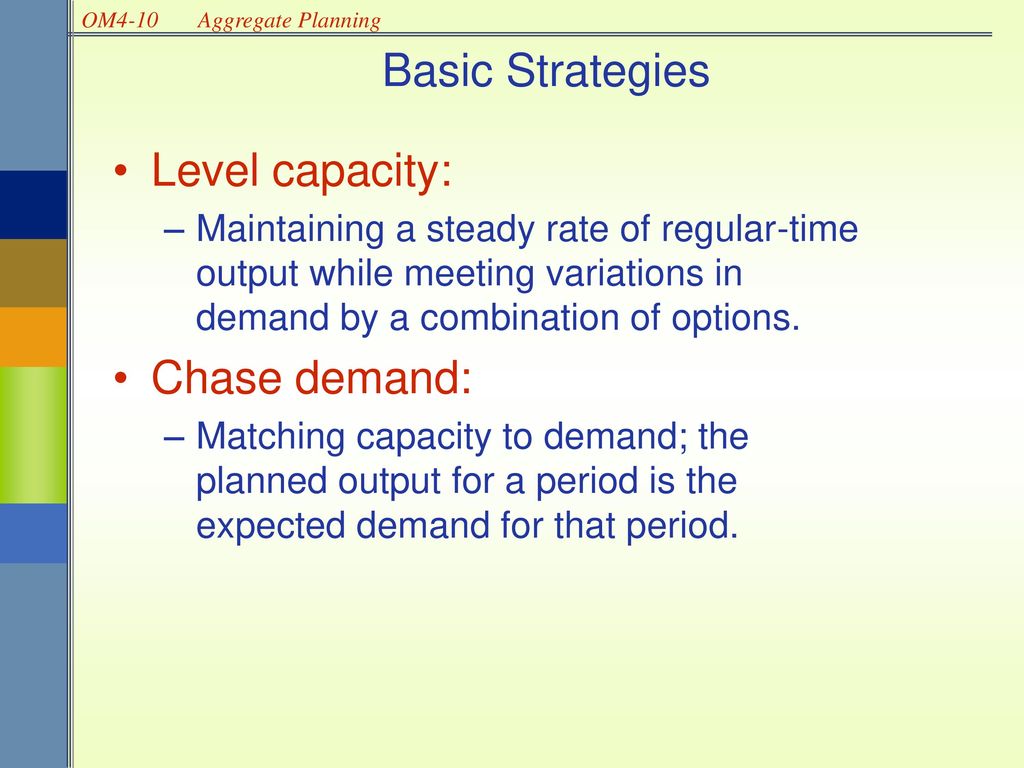



Chapter 14 Aggregate Planning Ppt Download




Discussion Ch08 Pdf Inventory Supply Chain
The strategy used is Level Strategy (variation amount of inventory) and Chase Strategy (variation of the number of employees) Aggregate planning aims to increase the load facility, adequacy test capacity to meet existing demand, capacity planning changes to meet fluctuations in demand and get the best solutions with the resources availableThe Aggregate Planning Problem •Given the demand forecast for each period in the planning horizon •Determine the production level, inventory level, and the capacity level for each period that maximizes the firm's (supply chain's) profit over the planning horizon •Specify the planning horizon (typically 318• An aggregated level of demand for one or few categories of product • The possibility of changing both supply and demand Chase versus Level Strategy Chase Demand Level Capacity Level of labor skill required Low High Job discretion Low High Compensation rate Low High




Aggregate Planning Studiousguy




Chapter 11 Managing Capacity And Demand Chapter 11 Managing Capacity And Demand Service Capacity Is A Perishable Commodity For Example A Plane Flying Course Hero
Demand forecasting is the art and science of forecasting customer demand to drive holistic execution of such demand by corporate supply chain and business management Demand forecasting involves techniques including both informal methods, such as educated guesses, and quantitative methods, such as the use of historical sales data and statistical techniques orThe planned output for a period is set at the expected demand for that period Maintain a steady output rate Match demand period by period Use a combination of decision variables Basic Strategies Level capacity strategy Maintaining a steady rate of regulartime output while meetingSafety How works Test new features Press Copyright Contact us Creators



Aggregate Production Planning Operations Management Homework And Assignment Help
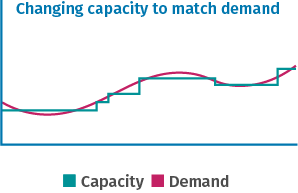



Ensuring Capacity Matches Demand Business Govt Nz
About Press Copyright Contact us Creators Advertise Developers Terms Privacy Policy &The present study proposes a novel decision model to aggregate production planning (APP) decision making problem based on mixed chase and level strategy under uncertainty where the market demandChase demand strategy ( variable output plan ) An approach to aggregate planning that attempts to match supply and output with fluctuating demand Depending on the product or service involved, the approach can incur costs by the ineffective use of capacity at periods of low demand, by the need to recruit or lay off staff, by learningcurve




Demand And Capacity Management Decision Steps Download Scientific Diagram




Solution S Op Planning Studypool
Level capacity strategy In this type of strategy, a constant regular time output rate is maintained while meeting the demand variations by a different combination of options b Chase demand strategy In this type of strategy the capacity is matched to the level of demand A period's planned quantity of output is equal to that period'sThe chase demand technique, revealed in Figure 114( b), matches the production strategy to the demand pattern and soaks up variations in demand by employing and shooting employees TECHNIQUES TO MATCH DEMAND AND CAPACITY The most essential task of the service online marketer is stabilizing/ matching the demand and capabilityThe first is called level scheduling, where you try and maintain a steady workforce with a steady schedule The second is the chase strategy, where you maintain a level workforce and increase your workforce as demand increases This may mean using overtime or hiring temporary employees The type of laborscheduling you wish to incorporate can




Solved Develop A Chase Strategy And A Level Strategy Using Chegg Com
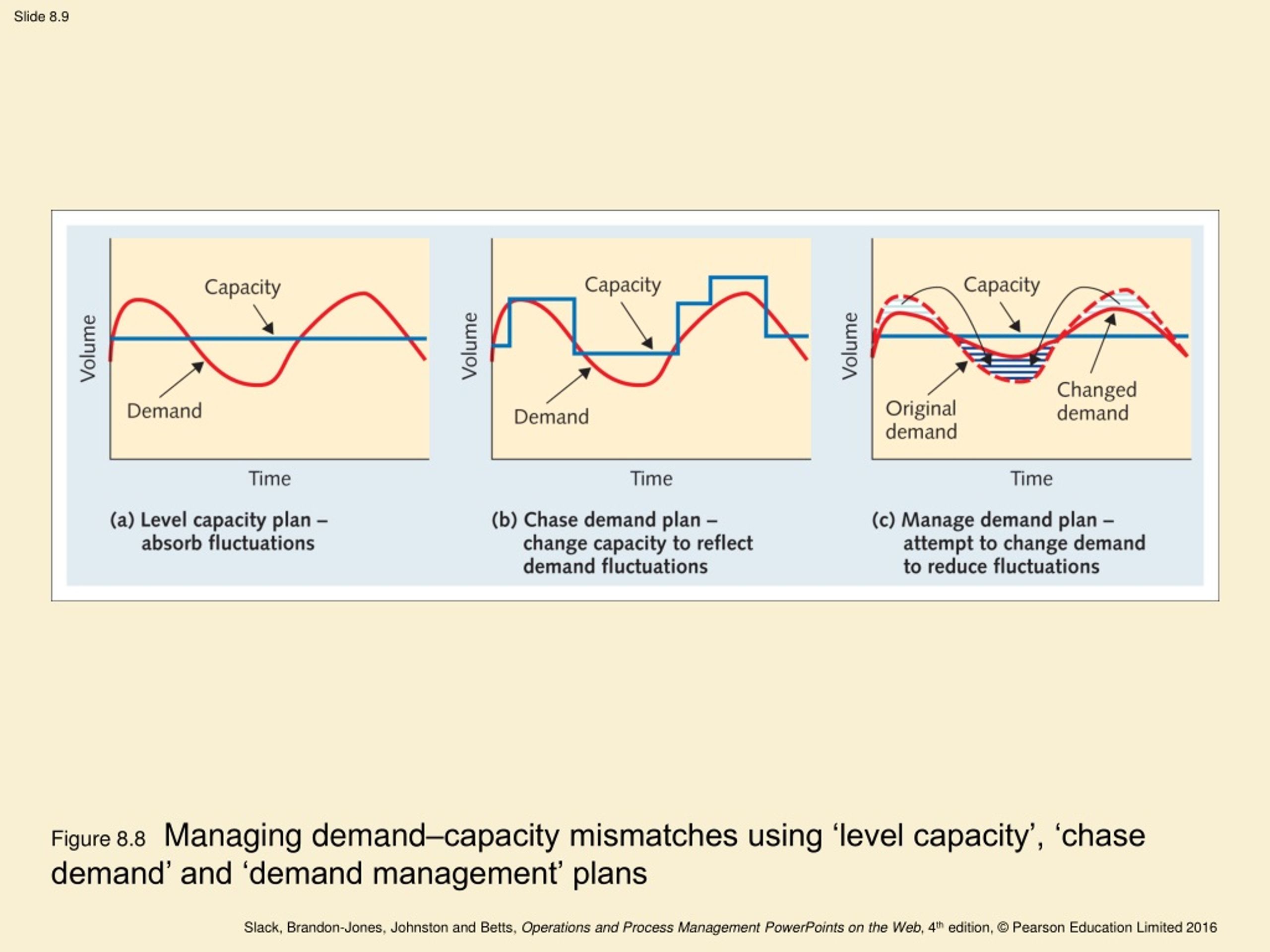



Ppt Chapter 8 Capacity Management Powerpoint Presentation Free Download Id
Chase demand strategy can be defined as a strategy where the changes are made to the output according to the demand Here, the changes are in terms of increasing or decreasing the output in line with the rising or falling demand It involves matching the demand by hiring or firing the workers or by controlling the level of production and usingAn approach to aggregate planning that attempts to match supply and output with fluctuating demand Depending on the product or service involved, the approach can incur costs by the ineffective use of capacity at periods of low demand, by the need to recruit or lay off staff, by learningcurve effects, and by a possible loss of quality The advantages include low storage{ The Justintime production plan, also known as the chase plan, consists in changing the production rate to exactly satisfy demand The idea is consistent with the JIT production philosophy and results in low holding costs but may result in high cost of adjusting the production rate, ie, high flring and hiring costs or high idle times




Operations Management Daniel S Blog
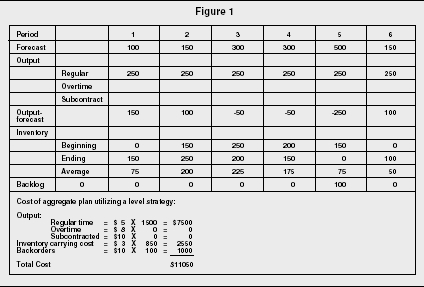



Aggregate Planning Strategy Organization Levels System Examples Model Type Company System
Up to12%cash backUnder the chase strategy, production is varied as demand varies With the level strategy, production remains at a constant level in spite of demand variations The use of a chase strategy requires that a company have the ability to readily change its output level, which means that it must be able to readily change its capacityAlign capacity with demand fluctuations This basic strategy is sometimes known as a "chase demand" strategy By adjusting service resources creatively, organizations can in effect chase the demand curves to match capacity with customer demand patternsQuestion Which statement is most correct concerning the aggregate planning strategies of Level, Chase, and Mixed?




Lecture 7 Managing Capacity And Demand Flashcards Quizlet
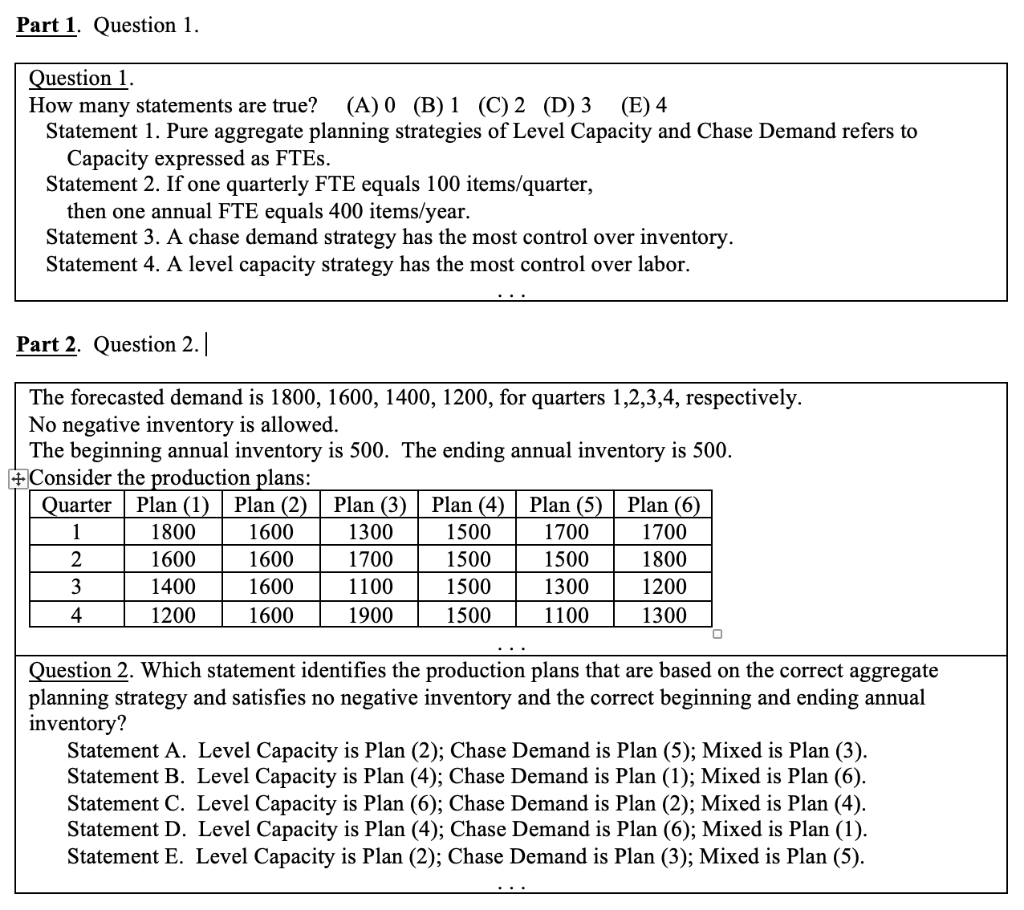



Solved Part 1 Question 1 Question 1 How Many Statements Chegg Com
View Homework3Questionsdocx from BANA 3000 at University of Colorado, Denver QUESTIONS – Homework #3 – Aggregate Planning BANA 3000,The level of capacity directly relates to the amount of output in the form of goods and services manufacturers can produce to satisfy customer demand Capacity planning strategies can guide manufacturers on how much raw materials, equipment, labor, and investment in facilities need to be acquired over a period of time to meet the future demand1 Level capacity plan 2 Chasedemand plan 3 Demand management plan 4 Production plan QUESTION 7 Mona is the owner of a small, boutique store specialising in organic clothes She is currently busy setting performance standards for and has incorporated several industry benchmarks into her own performance standards Which type of performance standard is Mona




Sage Books Managing Service Operations Design And Implementation
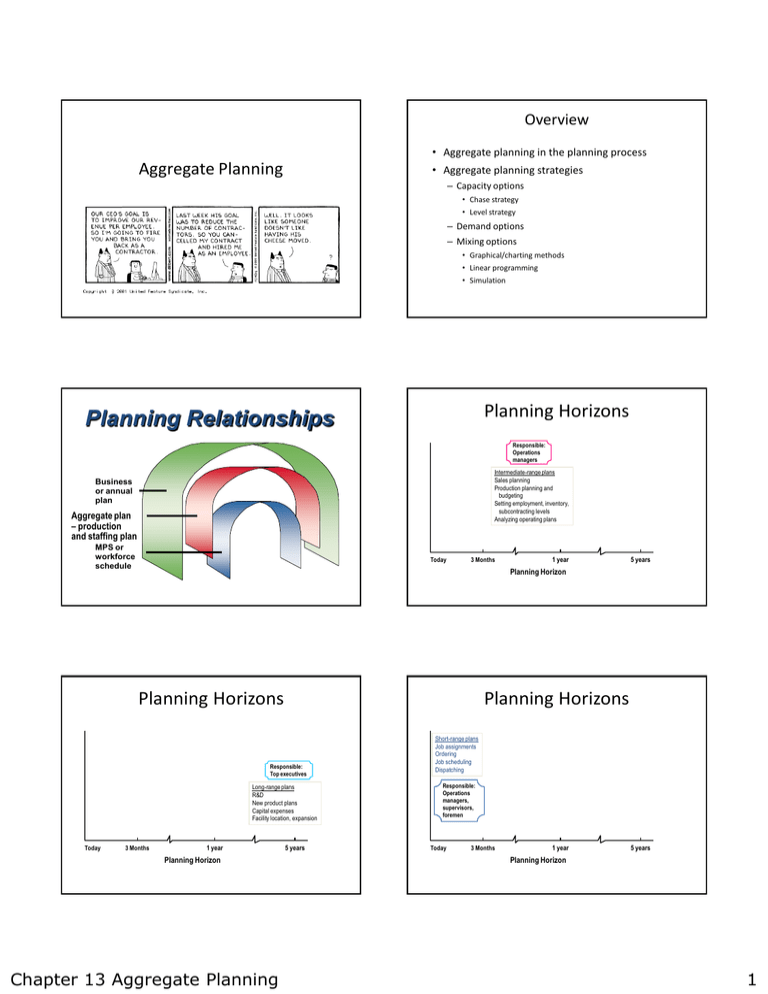



Planning Relationships Planning Horizons Aggregate Planning
The level and chase demand capacity utilization strategy is to be used as Level Strategy It is to be used when the same quality and quantity of the production procedures are requiredChase demand strategies Chase demand strategies are the totally opposite of level capacity in which the organisation frequently requirements to match levels of customer demand to its production volume as an example of JIT systems Such strategy will need the flexible employ of resources in order to accomplish achieve this for example1 Attempt to change demand to fit available capacity using demand management 2 Adjust capacity to reflect the fluctuations through a chase demand plan 3 Increase marketing activity and develop a chase demand plan 4 Ignore the fluctuations and apply a level capacity plan Increase marketing activity and develop a chase demand plan Read More




Aggregate Planning Intermediaterange Capacity Planning Usually Covers A
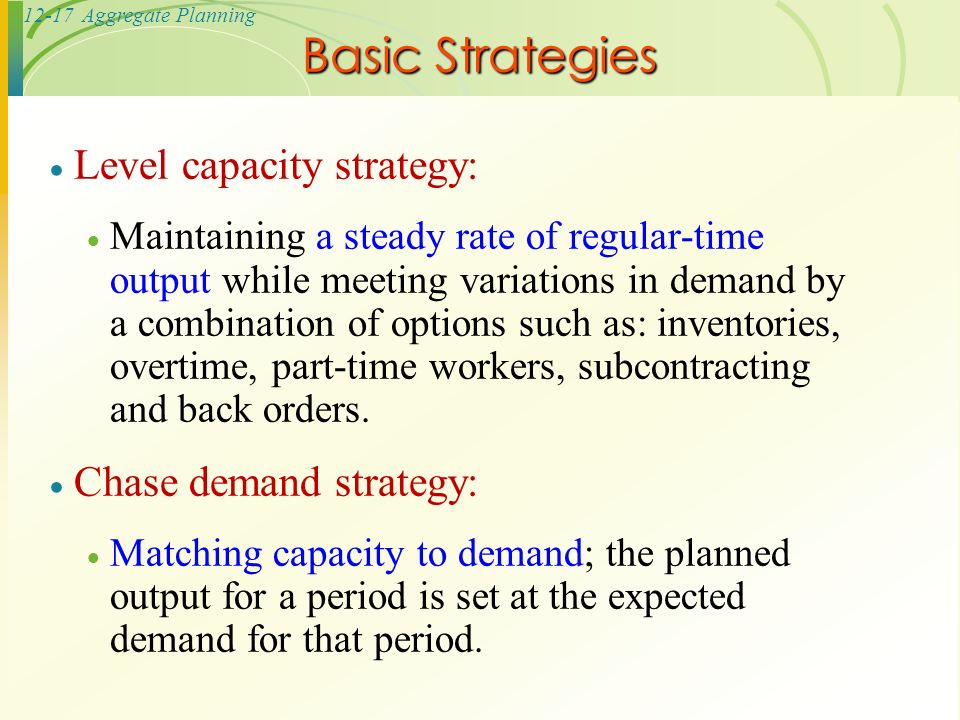



Operations Management Ppt Video Online Download
The actual capacity is the maximum amount of work that an organization is able to complete in a given period due to constraints such as quality problems, delays, material handling, etcA level capacity strategy is also known as a chase demand strategy False An advantage of a chase strategy for aggregate planning is that inventories can be kept relatively low True LinearA level capacity strategy attempts to keep capacity level with demand A) True B) False 9 A level strategy is more dependent on forecast accuracy than is a chase strategy A) True B) False 10 An advantage of a level approach is lower inventories than with a chase approach A) True B) False 11 A level approach works best when demand is stableAssume 0 units of initial inventory Extra capacity may be obtained by subcontracting at an additional cost of $15 per unit over and above the company's producing them itself on regular time Provide a detailed cost breakdown for using a level vs a chase strategy to meet the increased demand Which strategy do you recommend?




Introduction To Aggregate Planning And The 3 Plans Level And Chase Strategy Included Youtube
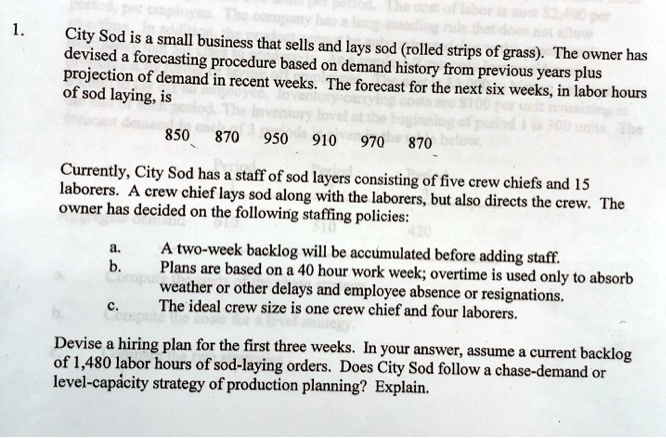



Solved City Sod Is Small Business That Sells And Devised Jays Forecasting Sod Rolled Strips Of Grass The Owner Has Procedure Based On Demand History Projection Of Demand In Recent Weeks From Previous
A) To ensure expected demand is less than the projected capacity in the planning horizon B) To create policies about demand and supply C) To achieve rough equality of demand and capacity over the entire planning horizon D) To ensure projected capacity is less than the expected demand in the planning horizonAbsorb demand Change demand Adjust output to match demand Level capacity Chase demand Demand management Ways of reconciling capacity and demand (Continued) 11




Match Supply And Demand In Service Industries
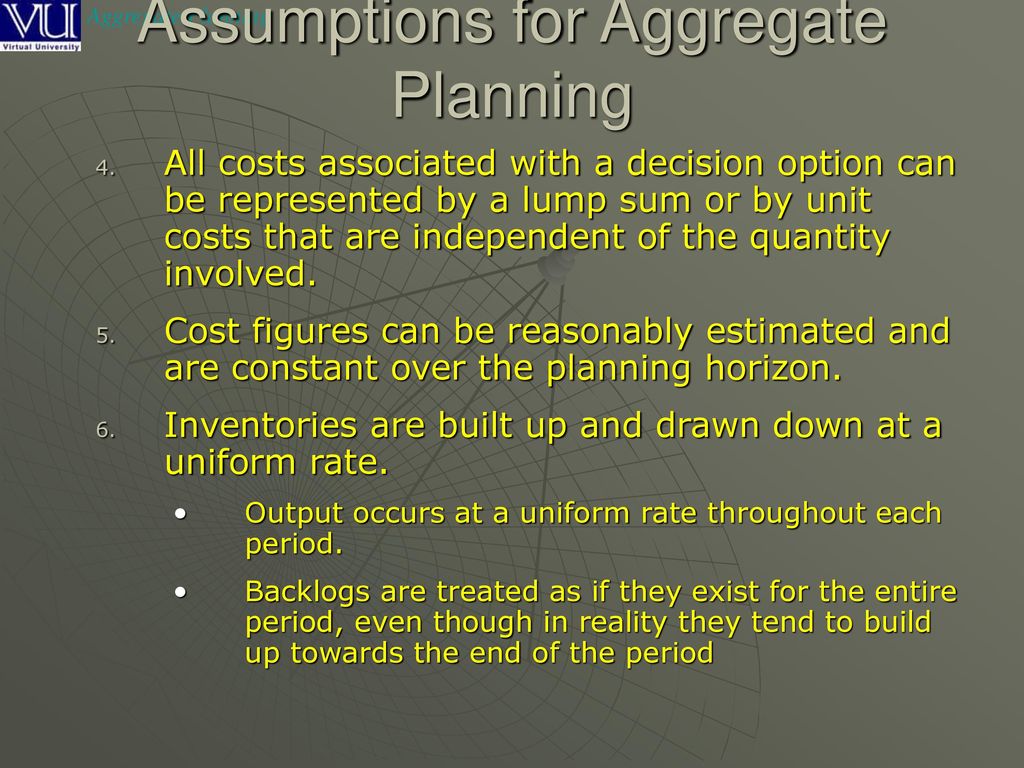



Basic Strategies Level Capacity Strategy Chase Demand Strategy Ppt Download



2




Managing Capacity Capacity Management Youtube



Call Centre Capacity Management Emerald Insight




Sample Practice Exam 15 Questions Studocu




Operations Management Chase Or Level Production Term Paper




Aggregate Planning Mps Capacity Planning Pdf Strategic Management Inventory




Entries For Thursday 25 October 07 Sergio S Blog
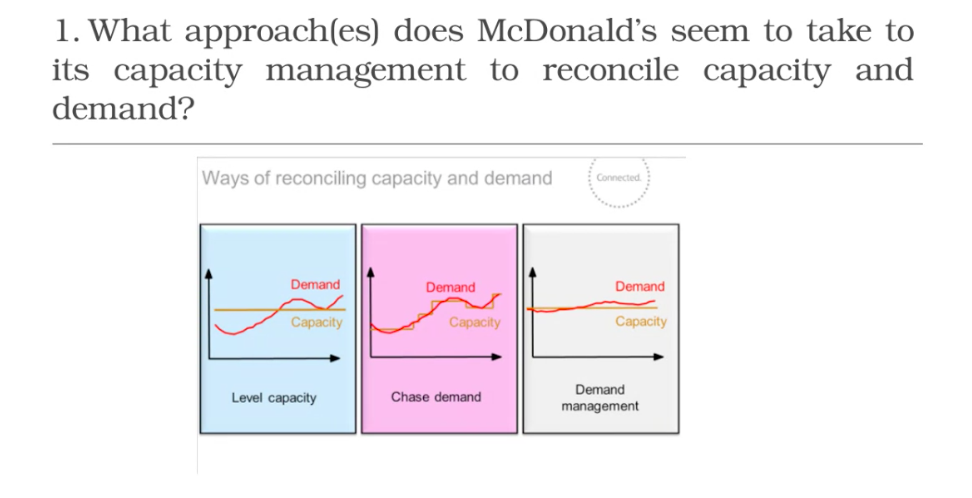



Solved Hi Could Helop Me Please With This Task By Guiding Me Chegg Com
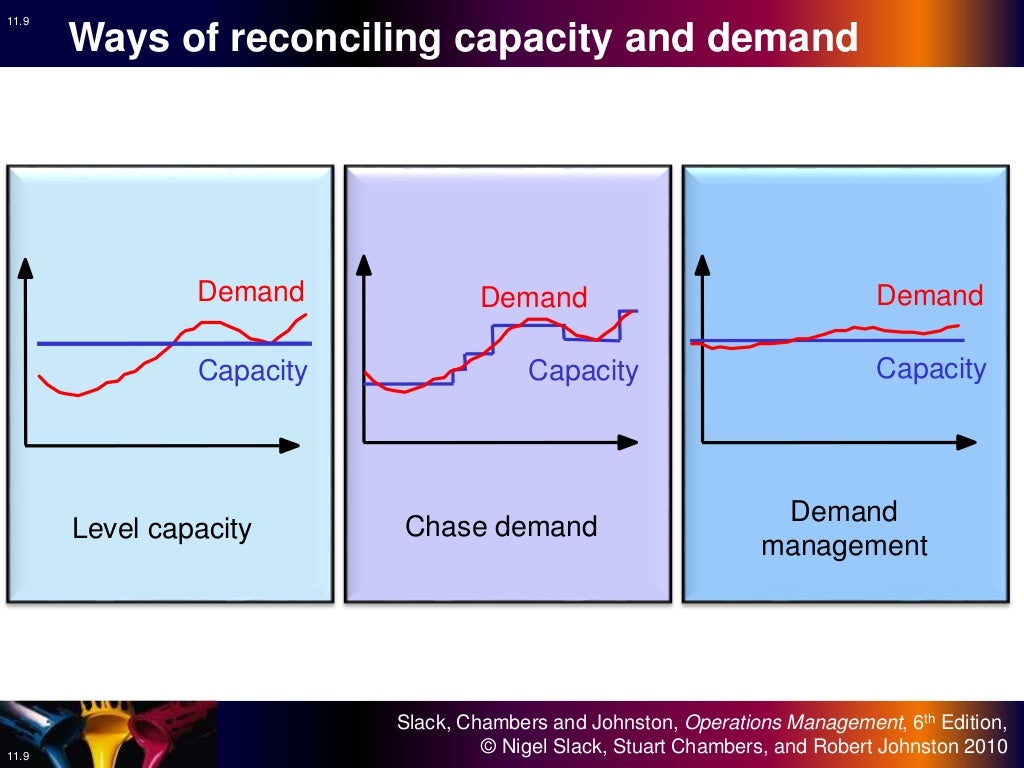



11 Capacity Planning And Control Operations Management



M Dc Operations Strategy
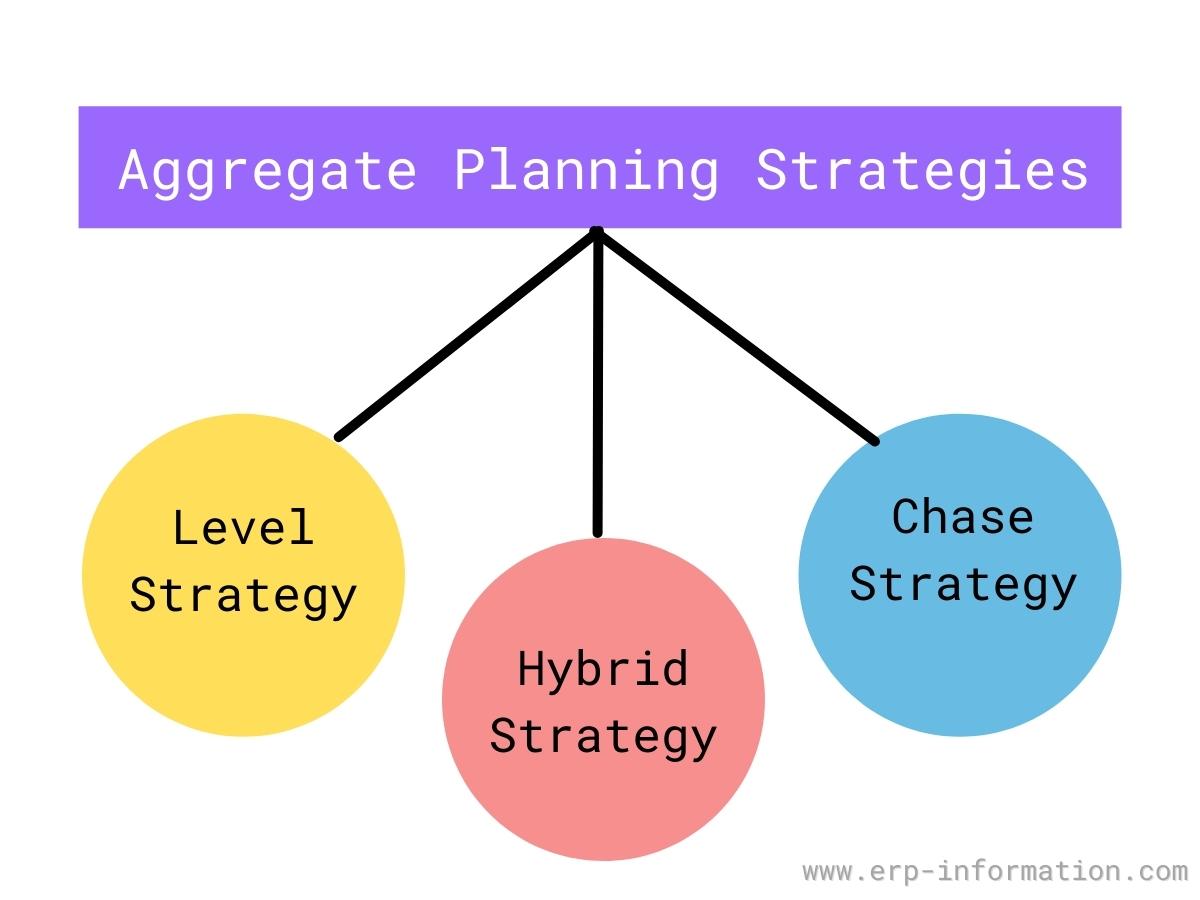



What Is Aggregate Planning 3 Strategies For Aggregate Production Planning




Test Bank For Heizer Operations Management 9e Str 36




Solved Question 4 4 Points Two Strategies For Matching Chegg Com




Demand And Capacity Planning In The Emergency Department How To Do It Emergency Medicine Journal



1
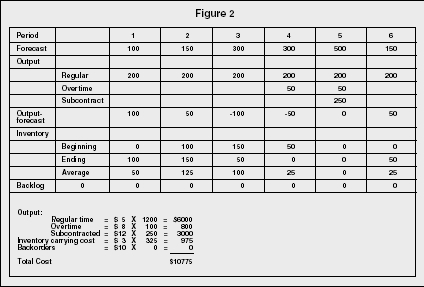



Aggregate Planning Strategy Organization Levels System Examples Model Type Company System




Aggregate Planning Strategies With Excel Dr Harper S Classroom Youtube




Demand And Capacity Management Options Adapted From Fitzsimmons And Download Scientific Diagram




Aggregate Planning Strategy Organization Levels System Examples Model Type Company System



2




Mcq S Week 7 Capacity Management Chapter 8 Week 7 Capacity Management Which Of The Following Studocu
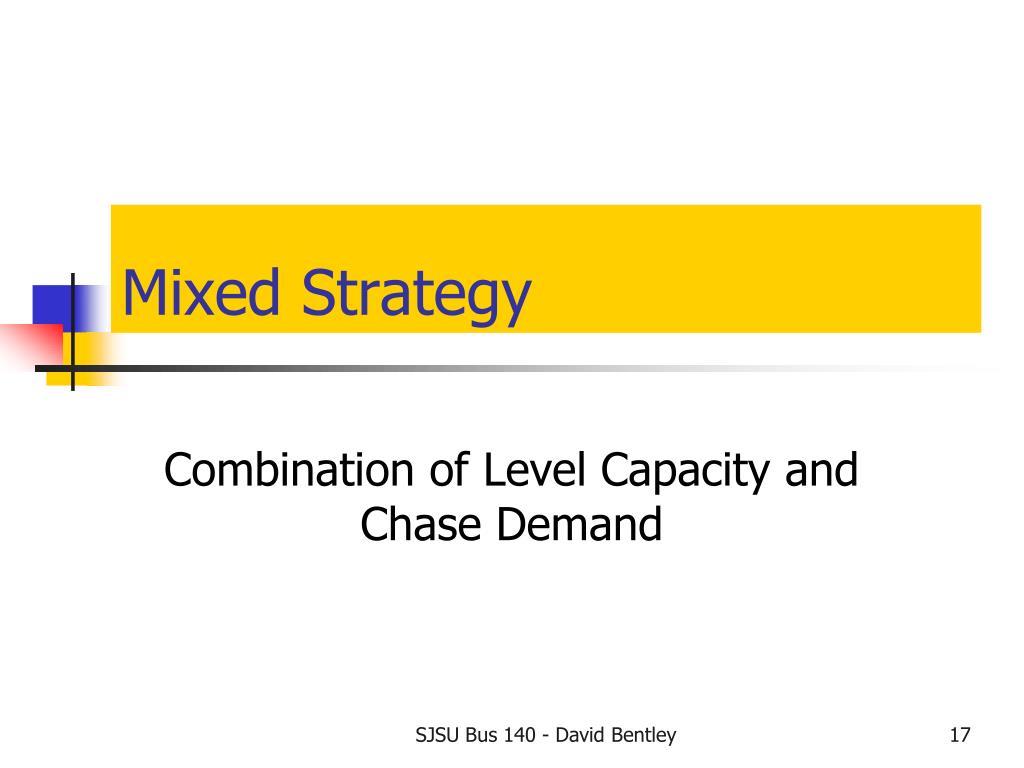



Ppt Week 13a Sales Operations Planning Chapter 13 Powerpoint Presentation Id




Demand And Capacity Management Decision Steps Download Scientific Diagram




Ppt Mgsm0 Operations Management Powerpoint Presentation Free Download Id
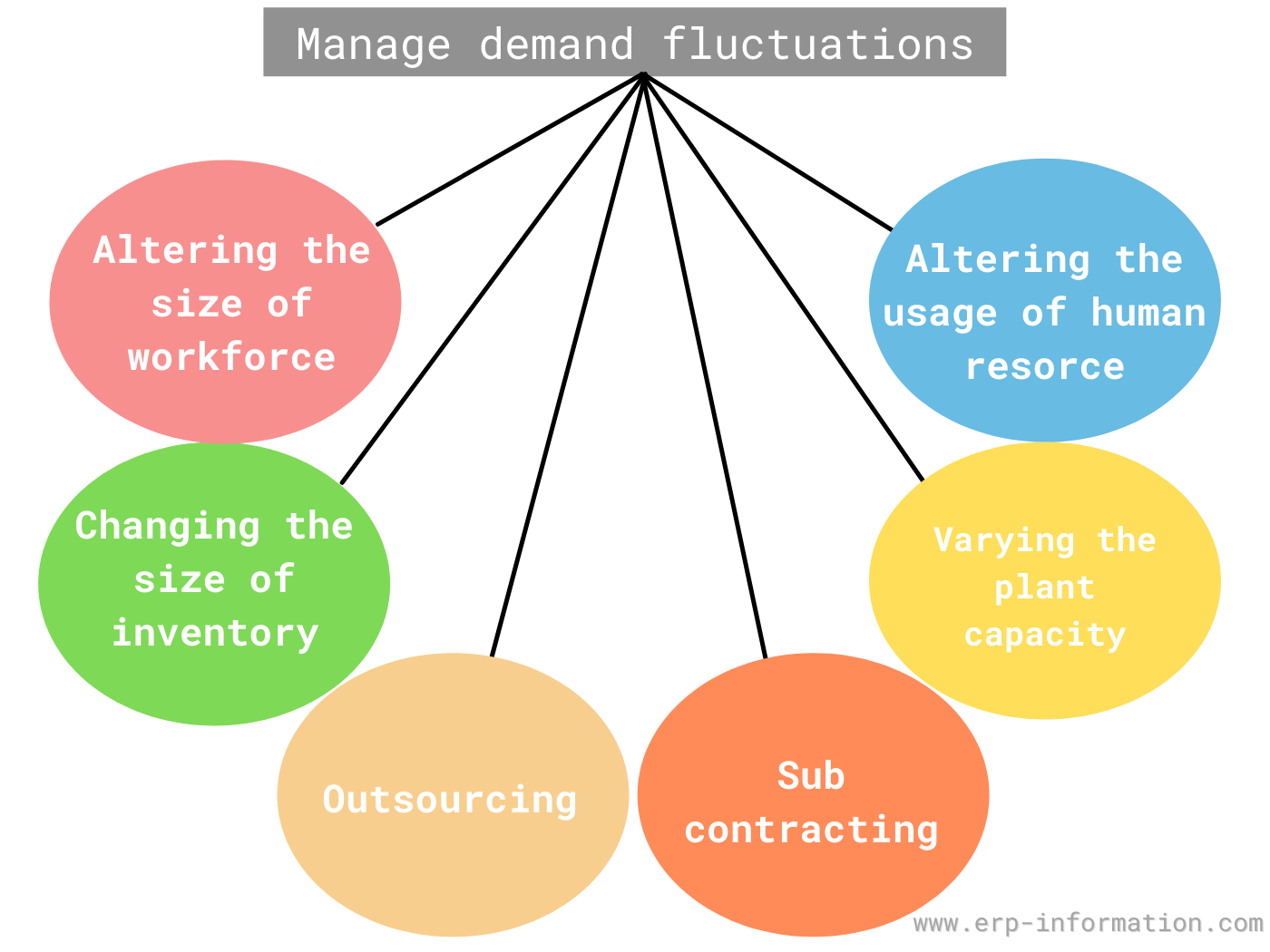



What Is Aggregate Planning 3 Strategies For Aggregate Production Planning




Logistics And Supply Chain Forum Aggregate Production Planning Part I




Chase Method Of Aggregate Planning




Aggregate Planning Chapter 11 Aggregate Planning Aggregate Planning




Week 3 Planning Control And Capacity Management Flashcards Quizlet
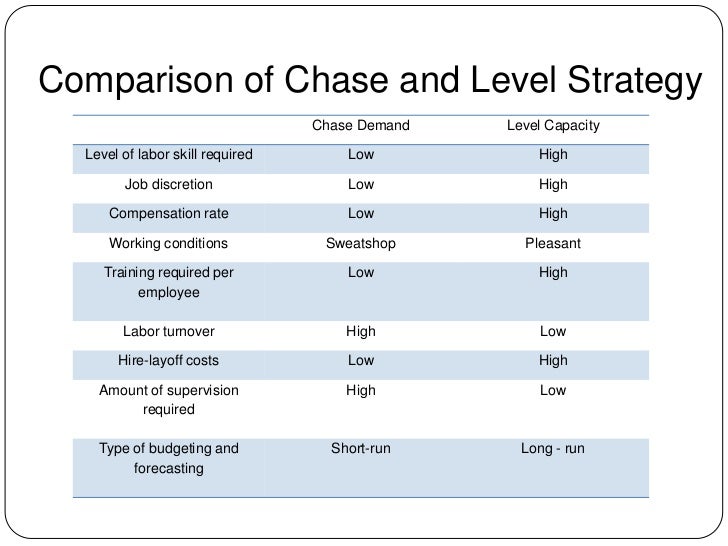



Aggregate Planning Report




Ppt Chapter 3 Aggregate Planning Steven Nahmias Powerpoint Presentation Id




Pdf Long Term Capacity Management Linking The Perspectives From Manufacturing Strategy And Sales And Operations Planning Semantic Scholar
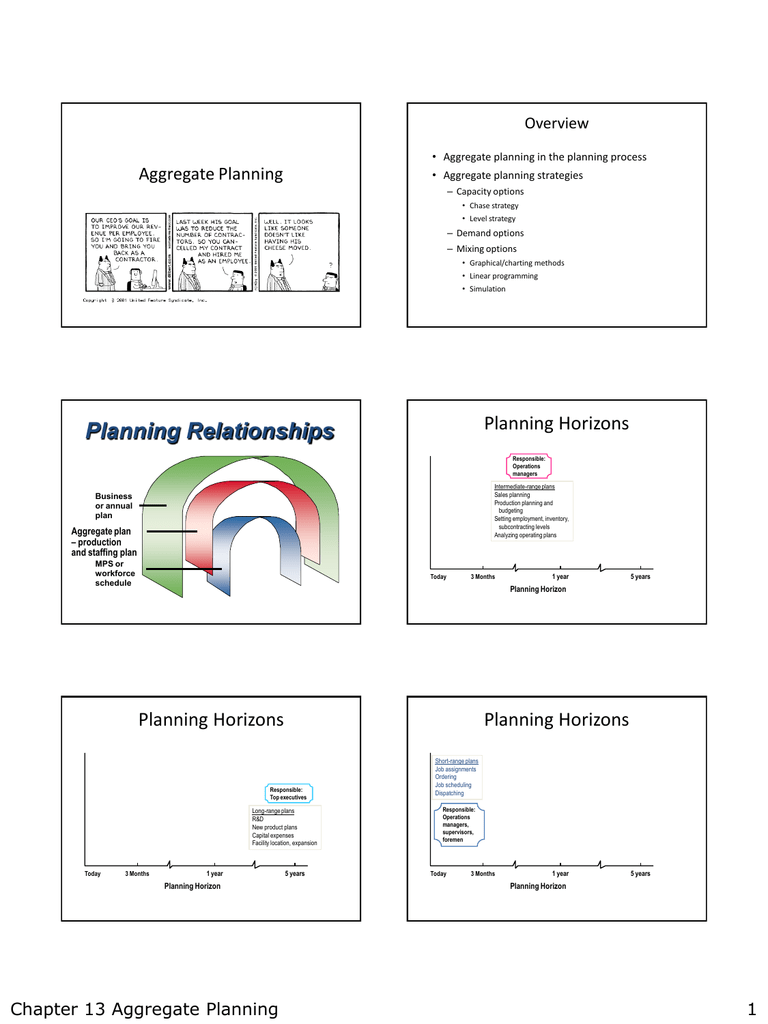



Planning Relationships Planning Horizons Aggregate Planning




Mba 8452 Systems And Operations Management Ppt Powerpoint




How Is Yield Management Implemented In Airline Industry Ayat Saleh




Topic 2 Aggregate Planning Direccio D Operacions Internacionals Studocu




Mcq S Week 7 Capacity Management Chapter 8 Week 7 Capacity Management Which Of The Following Studocu



2
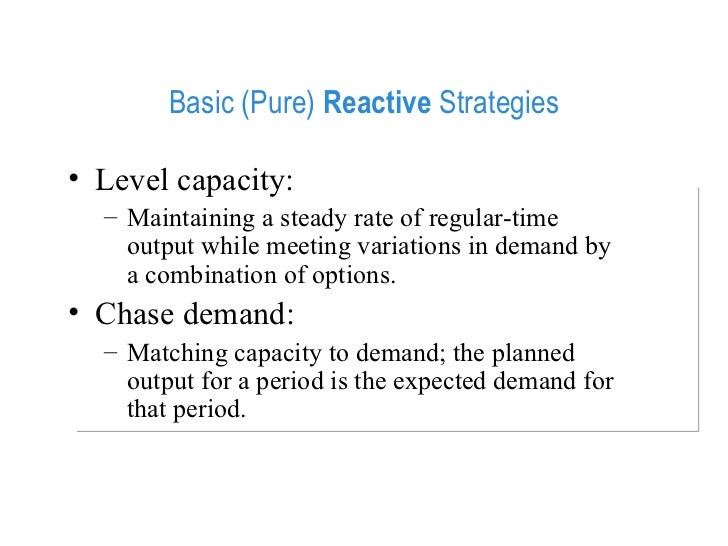



Aggregate Planning




Understanding The Effects Of Chasing Demand Vs Capping Your Capacity Dog Trainer S Umbrella
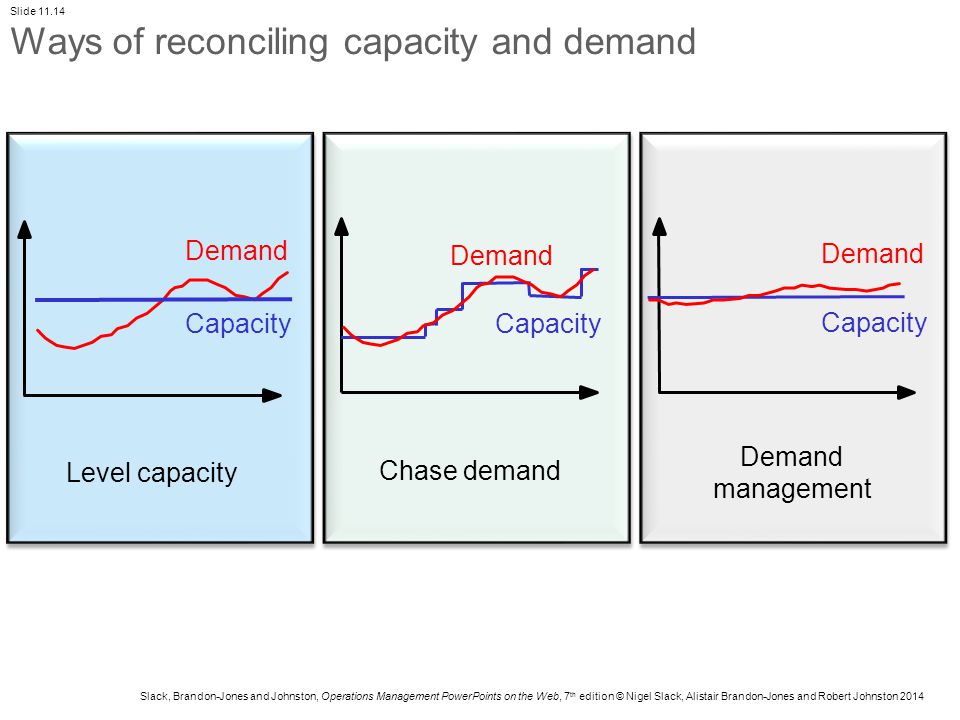



Chapter 11 Capacity Management Ppt Video Online Download
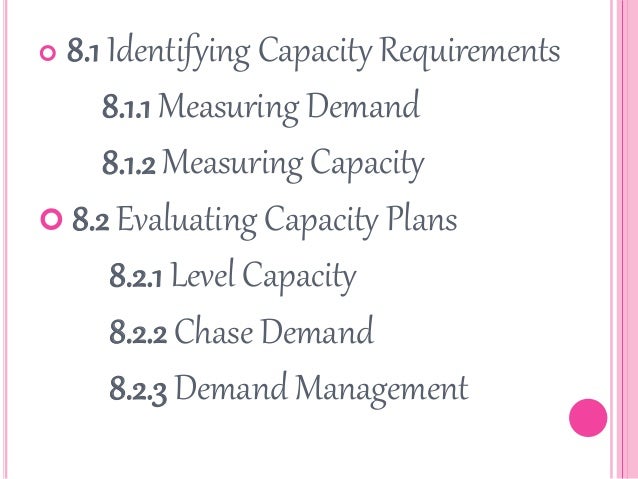



Capacity Planning




Hb52 Mba Mps Flashcards Cram Com
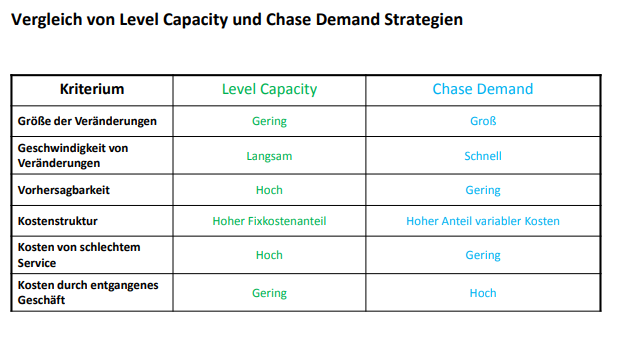



Vergleich Von Level Capacity Und Chase Demand Strategien Operations Management I Repetico
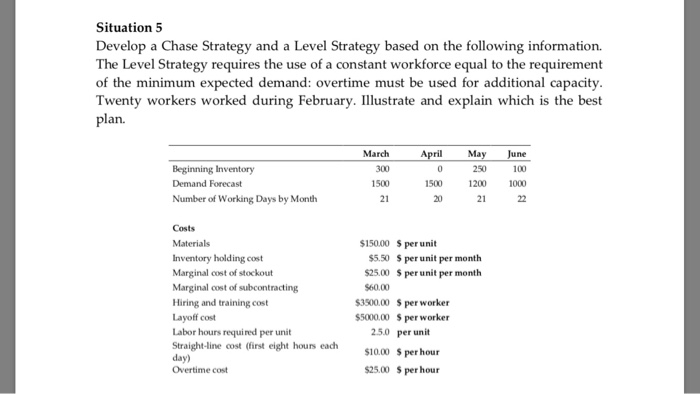



Solved Situation 5 Develop A Chase Strategy And A Level Chegg Com




Basic Strategies Level Capacity Strategy Chase Demand Strategy Ppt Download




Aggregate Planning Mps Capacity Planning Pdf Strategic Management Inventory




Capacity Planning Jit And Lean Systems Online Presentation
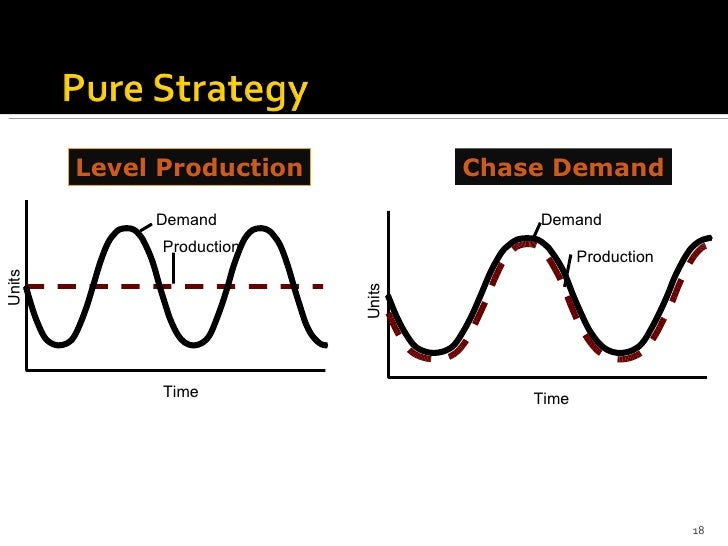



Productionplanning Aggregate Capacity




Aggregate Planning Strategies Pdf Inventory Economies



2




Aggregate Planning Youtube




Capacity Planning Q A Pdf Inventory Supply Chain




Capacity Planning And Control Chapter 11 What Is



1
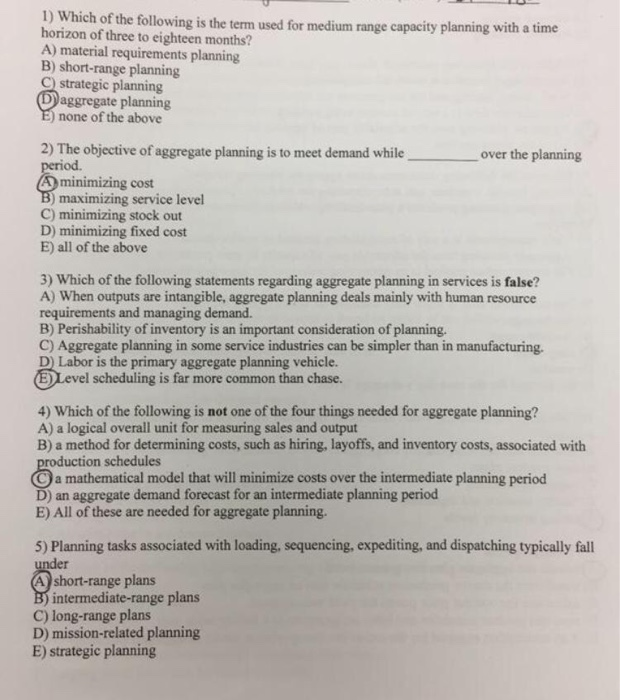



Solved M Which Of The Following Is The Term Used For Medium Chegg Com
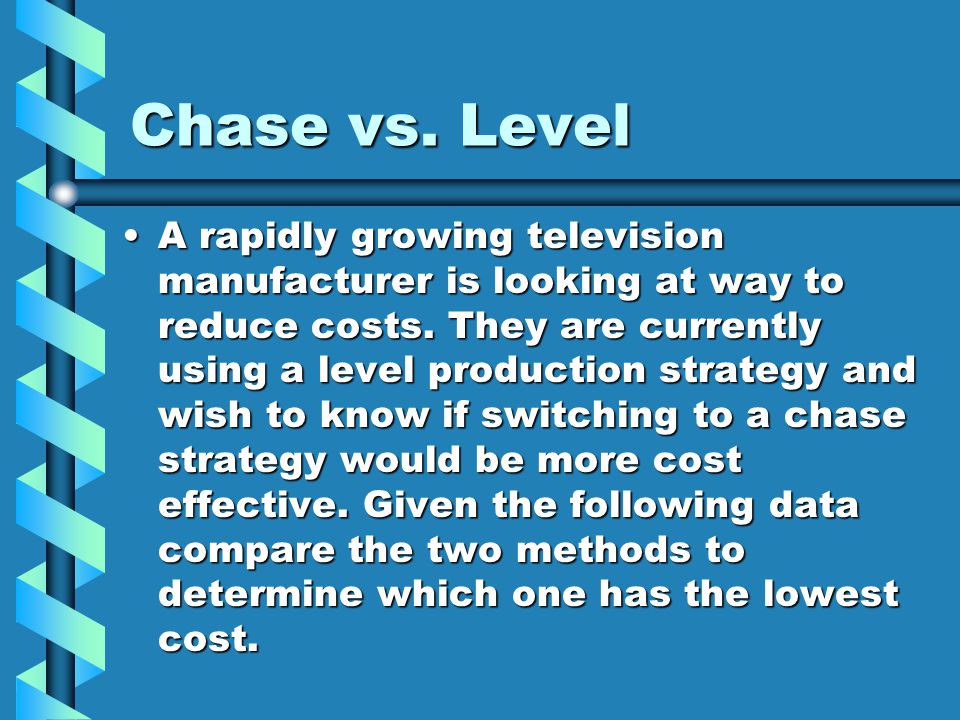



Chase Method Of Aggregate Planning Ppt Video Online Download




Aggregate Capacity Planning Pdf Free Download




Complete Guide To Chase Demand Strategy Welp Magazine
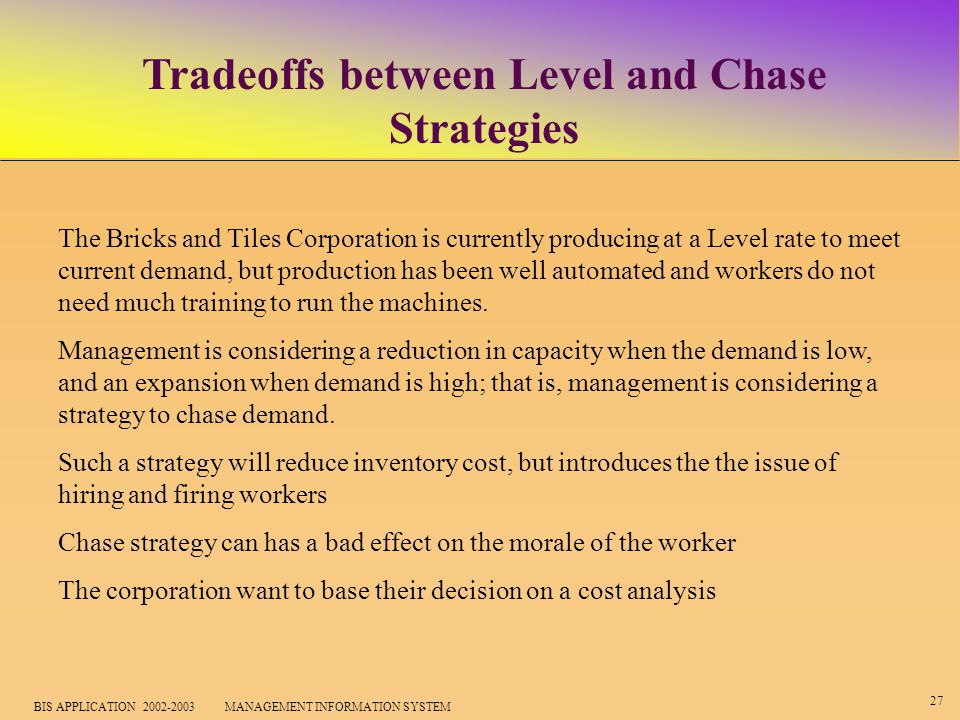



Chapter 5 Aggregate Planning Operations Analysis Using Ms Excel Ppt Download



1




Ppt Chapter 13 Aggregate Planning Powerpoint Presentation Free Download Id




Entries For Thursday 25 October 07 Sergio S Blog
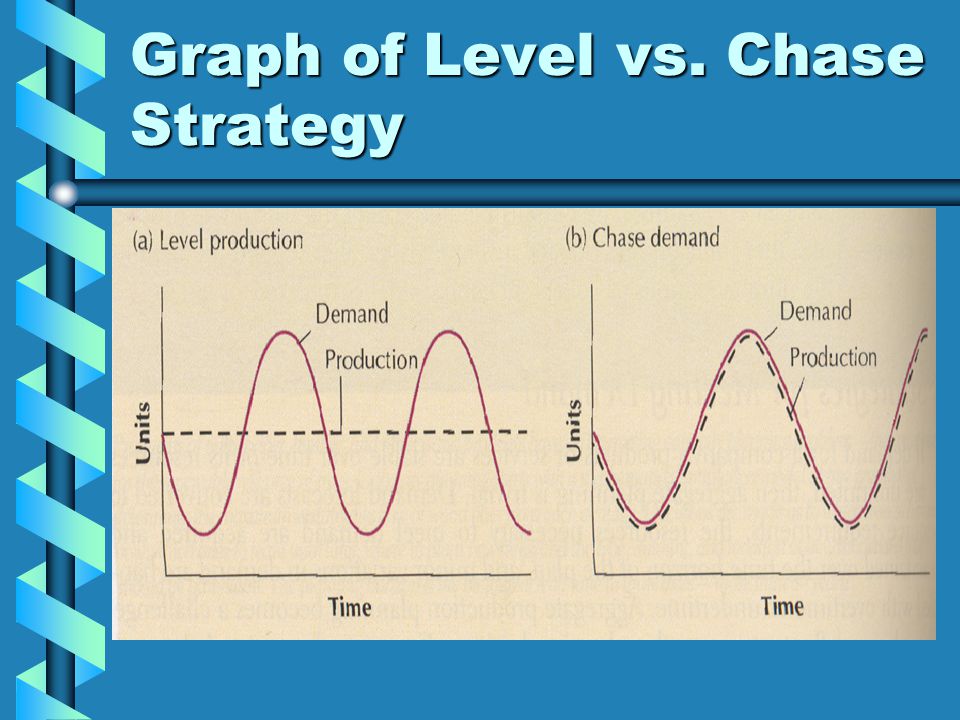



Chase Method Of Aggregate Planning Ppt Video Online Download




Pdf Evaluating The Performance Of Aggregate Production Planning Strategies Under Uncertainty In Soft Drink Industry Semantic Scholar




Aggregate Planning



Capacity




Sales And Operations Planning Aggregate Planning Production Planning




Chapter 11 Managing Capacity And Demand Mc Grawhillirwin




Aggregate Planning Chapter 11 Mis 373 Basic Operations Management Ppt Download




Aggregate Planning Planning Horizon Aggregate Planning Intermediate Range



2




Demand And Capacity Management Options Adapted From Fitzsimmons And Download Scientific Diagram




Inse6400 Principles Of Systems Engineering Production Instructor Dr Ayda Basyouni Office Ev Pdf Free Download




Review Of Comprehensive Final Exam Bit 3414 Docsity




Capacity And Aggregate Planning Aggregate Planning The Process




Chase Demand Strategy Chase Demand Strategy Quarter Spring Summer Fall Winter Sales Forecast 80 000 50 000 1 000 150 000 Production Plan 80 000 Course Hero




Study Of Manufacturing System Capacity Planning Control Steps In Capacity Planning Measuring Demand Capacity Yield Management



0 件のコメント:
コメントを投稿